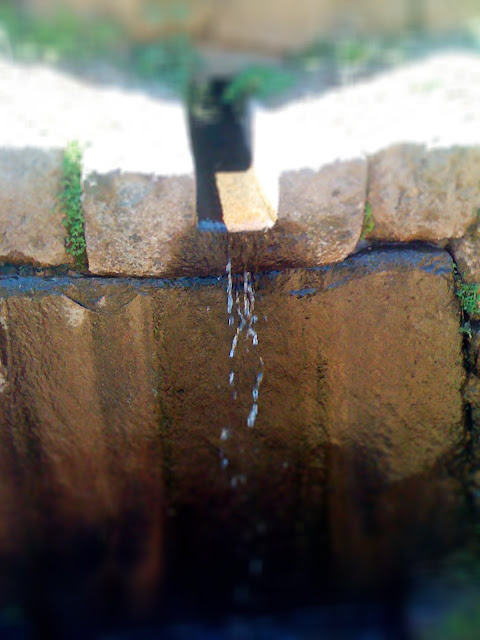There is a reason why there aren't photos of wine here (except a strange medio y medio). Well, two reasons really: first I didn't drink much wine, it doesn't really go well with active traveling with kids, second, there is good wine in South America, especially Chile and Argentina, but I mostly just drunk a glass at night in dimly lit restaurants, and the photos were too dark to publish.
But I can easily write a post mostly on some amazing non-alcoholic drinks, because they really give you a sense of the flavour of this part of the word. If you are a wine snob who judges a country by its tannins, well, sorry! But there is some alcohol, I promise, just scroll down to the end. And if you are into smoothies and fruit drinks... read on!
Jugos y licuados
Juices and smoothies

On the left there is an example of what you get in Uruguay when you order a fruit smoothie. Fruit and water based, they are cheap and they often serve you a full glass plus a jug to refill it. Best flavours for us were strawberry (
frutilla), peach (
durazno) or the combo with both frutilla e durazno! If you cannot choose go for a
tutti frutti, which usually had these plus apple, orange, banana or whatever fruit is available. The only problem is that sometimes they add sugar, so ask for no sugar if you prefer.
In Buenos Aires the extra jug disappears (pity) and strawberry and peach still dominate as the preferred lavours, although but many cafes are really into barley grass, carrot, and other healthy additions.
In Chile they don't seem to have the strawberry or peach, but their best liquado (fresh fruit juice or smoothie) is definitely raspberry! We also tried
cherimoya, but no, we all ordered raspberry over and over again. Try it, ask for
frambuesa.
Move to Peru and the choice becomes more tropical: papaya, pineapple and sometimes mango are the tips on offer. Here they tend to do juices rather than smoothies, but the papaya is thick like a smoothie. Above we have from left: papaya, orange, pineapple and melon.

And if you have to choose between a papaya juice and a Inca Kola... don't go for the Inca Kola! This is a super sweet and fizzy drink produced locally by Coca Cola that tastes of yellow food colouring, it may be popular in Peru, but I didn't like it at all! In fact I was surprised to see how many people in South America drink soft drinks. In Uruguay and Argentina I saw people (adults) drinking mostly Coca Cola with their dinner, whatever that was pasta or mains.
Coolest drinking experience in Montevideo
If you are visiting Montevideo a suggest a trip to the
Sofitel (unless you are lucky enough to stay there!). The Sofitel is the new name of the beautiful old
Hotel Carrasco which was built between 1912 and 1921. If you have tea or coffee there is a trolly full of delicious pastries to choose from, and if you have a drink... well, the menu is never ending, and the kids and Peter had some lovely virgin cocktails (yes Peter too because he was driving). I had a red wine. But let's look at the interiors first!

Just for fun: the ladies' powder room is entirely lined with mirrors, perfect for a photo chance before trying to find the exit!
Strangest drink in Montevideo:
This has to be the medio y medio, originally from the Bar Roldos, in the Mercato del Porto (not a market but a place full of restaurants and bars, and grilled meat smoke - very characteristic!). Apparently this is the city's most famous drink, they say that it is half wine (white originally, but red and rose are also available) and half Champagne. I can assure you that there is no Champagne in there, the other half is a sort of cider, and I have no idea why they call it Champagne. If you don't eat meat go and have a glass (just for the experience, not because I think that it is particularly good!) with a sandwich.
Best cultural experience

In Argentina and Uruguay (and parts of Chile) they drink
yerba mate. This is a must try, but you need friends to show you how! Or read about it
here.
Getting back to Peru now:
The sweetest drink (after the Inca Kola) is
Chica Morada. It tastes just like the Italian amarena cherry drink. I also had a dessert with purple corn sauce (yes, just like a red amarena cherry sauce...) and I guess that it could be said that this is what real corn syrup is supposed to be like.
More liquid observations
 |
| Best beer |
And best cocktail is:
Pisco sour! This is really something different! I liked the look of it, and the taste too, a bit like an alcoholic (but not so sweet) lemon meringue pie drink. In fact the bottom is lemon and the white foam is egg white! Of course when they make it everything is shaken together (except the drop of Angostura that decorates the top) and then the foam rises to the top. There are several videos on YouTube to see how it is made. Vegans rest assured: you can order a pisco sour
sin huevo (without egg).
Photos by Alessandra Zecchini ©




















































